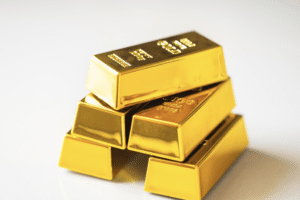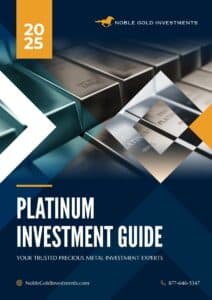AISC is a term that has become increasingly popular in recent years as more investors have begun to take investment tracking into their own hands. But how does AISC impact gold’s supply and the price of gold?
Whether you’re buying physical gold bars or gold coins to store at home or saving for retirement with a precious metals IRA, understanding all-in-sustaining costs will help you to make better long-term investment decisions.
What Are All-In Sustaining Costs (AISC)?
All-in-sustaining costs (AISC) is a key metric for making predictions on the price and supply of gold. AISC measures the total cost associated with sustaining gold production. This figure represents the total amount that must be spent to maintain current levels of gold production over time.
Components Of AISC
The components that go into creating the AISC’s total include:
- Direct cash costs such as labor, fuel, supplies, and services
- Indirect costs, such as royalties
- Non-cash items like depreciation, taxes, financing charges, exploration expenditures, and capital investments for new equipment or mine expansions/improvements
- Administrative/general expenses, including salaries and benefits for management personnel
How Has The Gold Cost Reporting System Evolved?
The gold cost reporting system has evolved significantly since its inception in 1976. Initially, the Gold Institute published guidelines for standardizing the gold costs reporting system, which divided cash costs and total costs of mining. However, this basic system was insufficient to accurately reflect the true cost of production when gold prices reached US$800 per ounce in 2008.
In response to this challenge, miners began developing new approaches to represent their profits accurately. Thus, the “all-in-sustaining cost” (AISC) system was invented in 2013. This AISC approach is now widely accepted by many major gold producers worldwide and is used as a benchmark measure of profitability within the industry.
Another important development in recent years has been increased transparency regarding disclosure requirements for companies involved in precious metals trading or production activities.
Companies must now provide detailed information about their business practices, including details on reserves, resource estimates, and capital expenditure plans, so investors can make informed decisions about investing in these companies or buying their products or services.
How The AISC Affects The Gold Supply And Price
The All-In Sustaining Cost (AISC) of gold mining is an important factor to consider when evaluating the price and supply of gold. AISC measures the total cost of producing one ounce of gold, including all direct costs such as labor, materials, energy, taxes, and royalties. When these costs increase, it puts downward pressure on the amount of gold that miners can produce.
This means that if AISCs rise but gold prices remain stagnant or decrease, miners will have less incentive to produce more gold since their profits are reduced. This, in turn, leads to a decrease in overall supply on the market, which could lead to higher prices for investors looking to buy physical bars or coins or invest in precious metals through a gold IRA account.
On the other hand, if AISCs remain steady but there is an increase in demand for gold due to economic uncertainty or geopolitical tensions, this could lead to a surge in prices as buyers compete for limited supplies available on the market. In this situation, miners would benefit from increased profits and may work harder at increasing production levels to take advantage of higher prices and greater profit potentials.
Ultimately understanding how changes in AISC affect both production levels and prices is essential for any investor who wants to maximize their returns when buying precious metals like silver, platinum, or palladium, either physically or through an IRA account. By keeping track of ASIC trends, you can better anticipate how much supply will be available on the market, which should help inform your investment decisions going forward.
Other Factors That Influence The Price Of Gold
While changes in AISC levels can affect prices significantly over time, other factors also influence their value. These include geopolitical events like wars or natural disasters, which can cause market volatility; supply and demand dynamics; inflation rates; currency exchange rates; interest rates set by central banks; investor sentiment towards precious metals investments; etcetera.
All these factors work together to determine what investors are willing to pay for each ounce of gold at any given moment – regardless of how much it costs miners to produce it initially through their operations’ all-in-sustaining costs (AISCs).
What Are The Advantages Of AISC?
AISC provides investors with more detailed information about the performance of their investments, provides greater transparency into their investments, and gives them more access to their investment data.
Tracks The Performance Of Their Investments
One significant advantage of AISC is that it allows investors to track the performance of their investments over time. This can be especially helpful for long-term investors who are looking to make sure they are making wise decisions with their money.
With AISC, an investor can easily see how much money has been earned or lost on each investment since its purchase date. They can also compare different investments against one another to determine which ones have performed better or worse over time.
Provides Greater Investment Transparency
Another benefit of using AISC is that it helps provide greater transparency into how companies use their funds and resources. By tracking income statement changes over time, investors can gain insight into where a company’s profits come from and what expenses they incur to generate those profits.
This level of detail gives them an understanding of the current state, prospects for the company’s success or failure, and any potential risks associated with investing in it.
Access Into Their Investment Data
AISC provides investors a clearer picture when evaluating stocks and other securities because of access to more comprehensive data points than just net income figures — which may not always tell the whole story behind a company’s performance or prospects for growth going forward.
Investors will be able to look at trends such as revenue growth rates, operating margins, and cash flow levels, which should give them better insights into whether or not certain stocks are worth investing in at any given time.
The Drawbacks Of AISC
While AISC provides valuable insight into the cost structure associated with gold mining operations, investors should be aware of its limitations before making decisions based on this type of analysis alone. It’s important to consider other factors, such as market trends and industry dynamics, when assessing whether or not investing in precious metals is right for you.
The System Is Complex
One major disadvantage of AISC is its complexity. The calculation includes many different factors, such as capital expenditures, operating costs, and exploration expenses, making it difficult for investors to understand what they’re looking at when evaluating a company’s financial performance.
Doesn’t Take Depreciation And Amortization Into Account
Another issue with AISC is that it doesn’t consider certain non-cash expenses like depreciation and amortization, which could impact the overall profitability of a company’s operations. This means that while AISC may provide an accurate picture of the margin associated with gold mining activities, it does not necessarily reflect the true economic value created by those activities over time.
Relies Heavily On Estimates
Since AISC relies heavily on estimates and assumptions about future prices and production levels for various metals, there is always a potential for inaccuracies or miscalculations in its results. This makes it difficult to accurately assess how much money a particular mine will generate over time without having access to detailed information about all aspects of its operations.
Overall, while AISC provides valuable insight into the cost structure associated with gold mining operations, investors should be aware of its limitations before making decisions based on this type of analysis alone. It’s important to consider other factors, such as market trends and industry dynamics, when assessing whether or not investing in precious metals is right for you.
What Are The Benefits Of Investing In Precious Metals?
Investing in precious metals, such as gold, silver, platinum, and palladium, can be a great way to diversify your portfolio and hedge against inflation. Investing in these types of assets through an IRA account has several benefits.
Tax Advantages Of A Precious Metals IRA
When you invest in precious metals through an IRA account, you can enjoy the tax advantages of it. This includes deferring taxes on any gains until retirement age or avoiding them altogether if you choose to roll over funds from another retirement plan into a self-directed IRA. Additionally, there may be additional deductions available depending on your situation.
Portfolio Diversification Benefits
By investing in precious metals instead of stocks and bonds, investors have the opportunity to diversify their portfolios which can help reduce risk while still allowing them to achieve their financial goals. The prices of stocks and bonds tend to move together when markets are volatile, but investments like gold often remain relatively stable during economic uncertainty, making it a great option for those looking for stability within their portfolio.
Precious Metals Are A Hedge Against Inflation
One of the biggest benefits of investing in precious metals is their ability to act as a hedge against inflation due to their intrinsic value not being tied directly to currency values or other economic factors like stocks and bonds.
As the cost of living increases over time due to inflationary pressures, so does the price of gold, which helps protect investors’ wealth by maintaining purchasing power despite market fluctuations or changes in interest rates.
Invest In A Gold Precious Metals IRA Today
AISC affects gold’s supply and price, and understanding how it works is essential before making investment decisions. Noble Gold Investments can help make your investment journey easy as we offer gold, silver, platinum, and palladium at competitive prices.
Investing in a precious metals IRA allows you to benefit from short-term tax advantages while saving for retirement. Now is the perfect time to take control of your financial future by investing in gold with Noble Gold Investments. Give us a call today to get started, our team is standing by to help open your account.







